Prevention is imperative for heart
failure with preserved ejection fraction.
Newswise, April 20, 2017– Lack of
exercise and excessive weight are strongly associated with a type of heart
failure that has a particularly poor prognosis, UT Southwestern Medical
Center researchers determined in an analysis of data from three large studies.
Heart failure is a chronic condition
in which the heart is unable to supply enough oxygenated blood to meet the
demands of the body.
Heart failure is approximately
equally divided between two subtypes: heart failure with preserved ejection
fraction (HFpEF) and heart failure with reduced ejection fraction (HFrEF).
Ejection fraction refers to the percentage of the blood that exits the heart
with each contraction.
“Previous studies have consistently
found an association between low levels of physical activity, high BMI, and
overall risk of heart failure, but this study shows that the association is
more pronounced for heart failure with preserved ejection fraction, the type of
heart failure that is the most challenging to treat,” said preventive
cardiologist Dr.
Jarett Berry, Associate Professor of
Internal Medicine at UT Southwestern, and the study’s senior author.
The study appears in the Journal
of the American College of Cardiology.
In heart failure with preserved
ejection fraction, the heart stiffens. Instead of being soft, it’s rigid and it
resists expansion.
Cardiologists often explain the
difference between the two types of heart failure by saying that in heart
failure with preserved ejection fraction, the heart doesn’t relax enough, while
in heart failure with reduced ejection fraction the heart doesn’t squeeze
enough. Many treatments have been developed for treating the latter but there
are no evidence-based treatments for the former.
“The five-year survival rate among
heart failure with preserved ejection fraction patients is around 30 to 40
percent. While heart failure with reduced ejection fraction survival has
improved significantly over the years, heart failure with preserved ejection
fraction prognosis is little changed,” said Dr. Ambarish Pandey, a cardiology
fellow in Internal Medicine at UT Southwestern Medical Center and first
author of the study.
The pooled analysis looked at data
from 51,000 participants in three cohort studies, the Women’s Health
Initiative, the Multiethnic Study of Atherosclerosis (MESA), and the
Cardiovascular Health Study. Among the 51,000 participants, there were 3,180
individuals who developed heart failure.
Of these, 39 percent were heart
failure with preserved ejection fraction, 29 percent were heart failure with reduced
ejection fraction, and 32 percent had not been classified when the data was
gathered.
The incidence of heart failure with
preserved ejection fraction was 19 percent lower for individuals who exercised
at recommended levels.
Similarly, body mass index (BMI) had
an inverse relationship with heart failure with preserved ejection fraction.
Higher BMI levels were more strongly associated with heart failure with
preserved ejection fraction than with heart failure with reduced ejection
fraction.
Heart failure with preserved
ejection fraction is a growing problem as the population ages, and is
particularly a problem among elderly women.
Medications such as ACE inhibitors,
beta blockers, and aldosterone antagonists have been shown in large-scale
randomized trials to reduce mortality in patients with heart failure with
reduced ejection fraction. Clinical trials have not identified medications that
reduce mortality in patients with heart failure with preserved ejection
fraction.
Heart transplant is the ultimate option
for some patients with heart failure with reduced ejection fraction but is not
an option for patients with heart failure with preserved ejection fraction, all
of which means that prevention is crucial for heart failure with preserved
ejection fraction.
“These findings highlight the
importance of lifestyle interventions such as increasing physical activity
levels and reducing weight to combat the growing burden of this disease,” said
Dr. Berry, Dedman Family Scholar in Clinical Care.
Other UT Southwestern
researchers who contributed to this study are Colby Ayers, faculty associate,
and Dr. James de Lemos, Professor of Internal Medicine and holder of the
Sweetheart Ball‐Kern Wildenthal, M.D., Ph.D. Distinguished Chair in
Cardiology.
Funding for this study was provided
by the American Heart Association.
Preventing heart failure:
•The American Heart Association
recommends 150 minutes per week of moderate exercise, 75 minutes per week of
vigorous exercise, or a mix of the two.
•A patient’s cardiorespiratory
fitness in middle age is particularly important in predicting the long-term
risk of heart failure.
About UT Southwestern Medical
Center
UT Southwestern, one of the
premier academic medical centers in the nation, integrates pioneering
biomedical research with exceptional clinical care and education. The
institution’s faculty includes many distinguished members, including six who
have been awarded Nobel Prizes since 1985. The faculty of almost 2,800 is
responsible for groundbreaking medical advances and is committed to translating
science-driven research quickly to new clinical treatments.
UT Southwestern physicians provide medical care in about 80 specialties to
more than 100,000 hospitalized patients and oversee approximately 2.2 million
outpatient visits a year.
To automatically receive news
releases from UT Southwestern via email, subscribe at www.utsouthwestern.edu/receivenews





